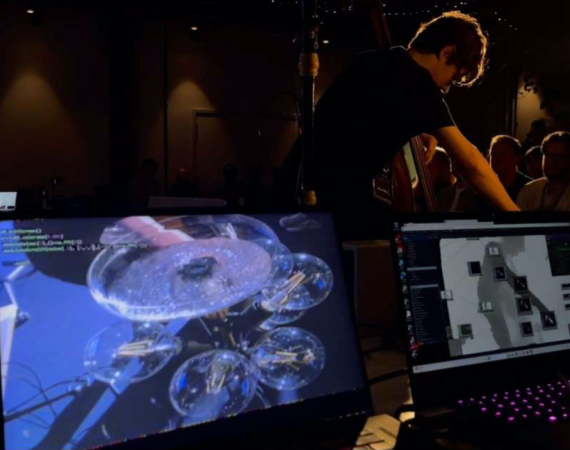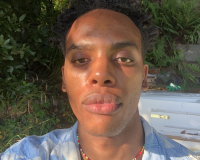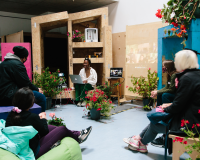Posted on Fri 28 Mar 2025
Knowle West Media Centre Fellowship Summary - Part 3
Reflections on the MyWorld Community Technology Infrastructure Fellowship - Conclusions

Watershed Sony Hackathon
Posted by

David Matunda
Web Developer, Digital Artist, Writer as well as a MyWorld's Fellow in residence at Knowle West Media Centre focusing on community tech and participation.Project

Fellowship in Residence: Community tech infrastructure: creative uses, community access and innovation
A 10 month practical MyWorld Fellowship aimed at exploring, testing and developing creative, accessible ways of utilising the growing KWMC community tech infrastructure.Community Tech Closing Thoughts:
In our conversation, Beckie used the term infrastructuring to acknowledge that the community tech work carried out by the media center relies on constant maintenance. This wasn’t lost on me as a user of open source software which can become unsafe to use when not maintained.
More funding and investment is needed to permanently hire full-time staff to balance the technical and creative challenges of meaningful community technology practice and the maintenance of the infrastructures to allow it to flourish.
There’s a future in which the infrastructuring and creative applications of all the community tech at KWMC is offered as something like an apprenticeship to someone from the area. Government subsidised apprenticeships are already offered across fields as varied as network engineering and arts therapy. It’s not unimaginable to see the infrastructure of community technology as a discipline where employment can be entered into in the same way. I think this would benefit KWMC and organisations at a similar level of community engagement, access to resources and ambitions for how they could empower their communities with the help of technology.
As with any opportunity there were challenges and mistakes to learn from. The Fellowship was only 2 and a half days a week so time was always limited but instead of seeing this as a limitation it encouraged quick prototype development and decisiveness.
Promising Trouble and their specific Community Tech programme has now ended. The language used to discuss community technology will probably always change but as mentioned earlier this kind of work is effective because of how embedded it is in the specific community it serves and the specificity of its location- the language and funding allocation for research into these types of technology practices doesn’t change the importance of this work.
The Watershed’s Pervasive Media Studio was another partner in this Fellowship and I checked in with producer Vanessa Bellaar Spruijt periodically throughout the residency. Vanessa connected me to Debs Durojaiye from Multitudes, a UK-based non-profit worker co-operative. The Multitudes case study on the Black Digital Archive is a comprehensive entry point for looking at community technology serving a different marginalised community. I found the work of multitudes and the Black Digital Archive inspiring and necessary. In my conversation with Debs, she highlighted the importance of infrastructure for community tech work.
A later conversation I would have with KWMC co-founder Carolyn Hassan would reinforce the importance of high quality equipment and aan argument against claims that KWMC could alienate residents in its local community by sticking out as an intimidating and highly modern building housing expensive tech in a historically deprived area.
To paraphrase Carolyn’s argument: just because an area is historically disadvantaged doesn’t mean the community does not deserve powerful, new, high-spec equipment to meet the technological demands of today. It’s also important to note that Knowle West residents consulted with architects and KWMC with the new building’s eco-friendly design. After a short presentation of my time on the Fellowship with the other two fellows from my cohort at Bristol Tech Fest, a member of the audience posed the same question about alienating residents because of the appearance of KWMC which I answered echoing these defenses.
But it was my next response to a follow-up question from the audience around the legacy of the Fellowship’s projects, prototypes, KWMC’s community technology infrastructure and the value of this work which has informed how I’ll frame my closing reflections from the Fellowship as an artist and creative technologist.
Conclusion & Further Work:
The KWMC Fellowship has been a transformative experience for my practice and I am eternally grateful to have met and worked with all the talented and driven people as a result of it.
I have also recognised that while my practice and experience as a creative technologist can meet some of the technical and creative demands of a residency like this, it wouldn’t be accurate to describe my artist practice as explicitly socially engaged or politically motivated moving forward. My interests in these issues hasn't changed but I do have a renewed sense of focus around the kind of work I want to make which is more nuanced.
I want to continue using code and doing live code performance. I'm still interested in image making and the idea of visual outputs of algorithms.
But I also want to elevate my approach to fabrication and how I physically realise work. I want to continue to hack together electronics and DIY prototypes to iterate from and develop ideas. The Fellowship was invaluable in providing the resources and supportive environment to clarify this for me.